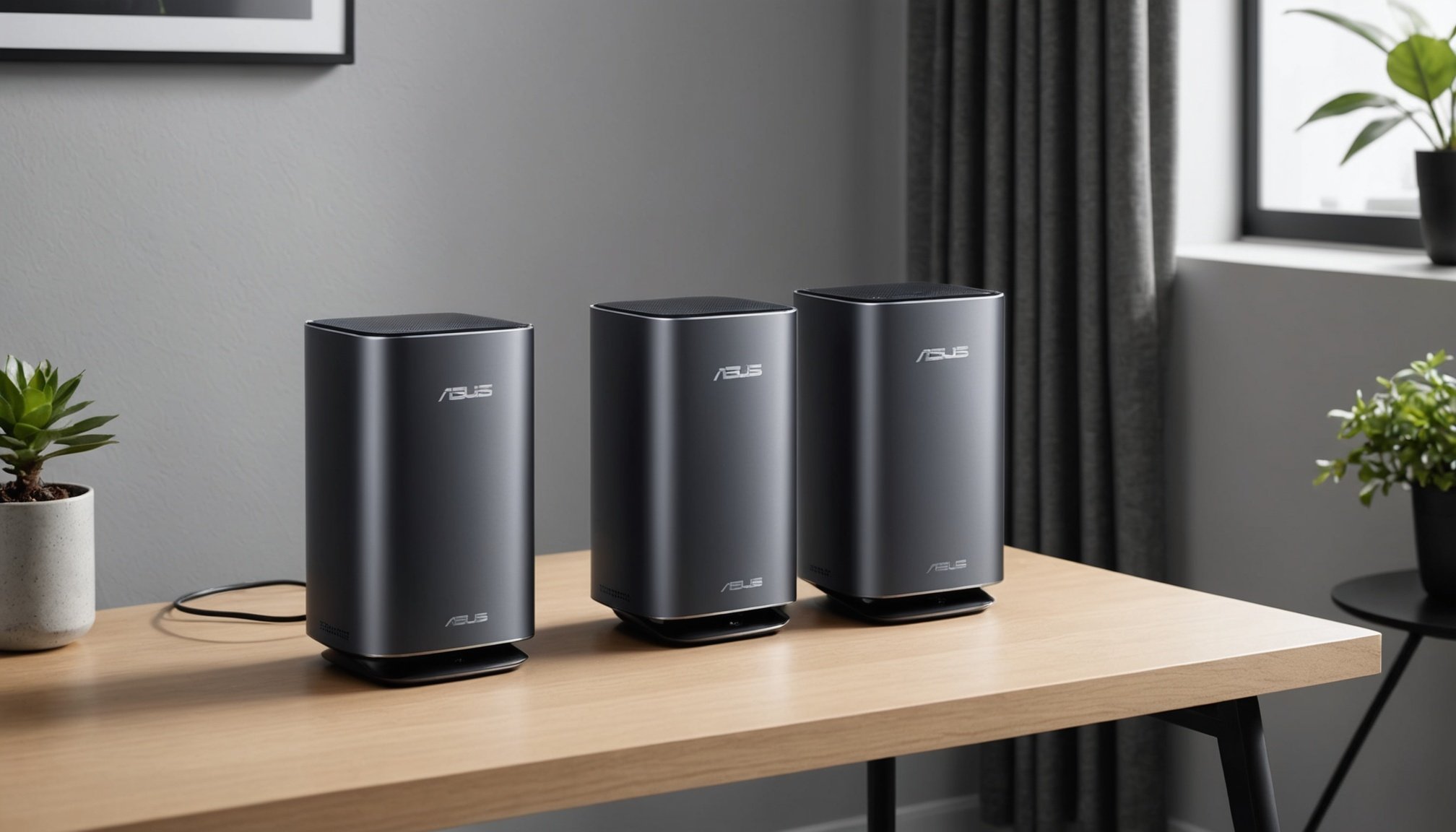Unlocking Full Wi-Fi Potential: Elevate Your ASUS ZenWiFi AX for Supreme Coverage Across Your Three-Story Home
Understanding Your ASUS ZenWiFi AX
When it comes to ensuring seamless Wi-Fi coverage across a three-story home, the ASUS ZenWiFi AX series is an excellent choice. These mesh systems are designed to provide robust and reliable wireless connectivity, but to get the most out of them, you need to understand their capabilities and how to optimize their performance.
Hardware Capabilities
The ASUS ZenWiFi AX series, including models like the ZenWiFi XT8, comes with advanced features such as tri-band Wi-Fi 6 or even quad-band Wi-Fi 6E support. These features allow for better bandwidth management and reduced congestion, especially in homes with multiple devices connected to the network.
For instance, the ZenWiFi XT8 supports the UNII-4 spectrum at 5.9GHz, which can significantly enhance your Wi-Fi speeds by utilizing additional bandwidth on the 5GHz band[5].
Optimizing Router and Mesh Node Placement
The placement of your router and mesh nodes is crucial for achieving optimal Wi-Fi coverage.
Have you seen this : Mastering remote connectivity: your ultimate guide to setting up a remote desktop on the lenovo thinkcentre m720q tiny
Vertical Placement
When deciding where to place your router and mesh nodes, consider the vertical placement. Here are some tips:
- Floor Placement: Placing the router or mesh nodes on the floor can lead to signal degradation due to interference from other devices and physical barriers.
- Mid-Height Placement: Positioning the devices at mid-height (e.g., on a shelf or table) can help distribute the signal more evenly throughout the home.
- Ceiling Mounting: While mounting on the ceiling might seem ideal, it can sometimes lead to signal loss due to the distance and potential interference from other devices. However, if done correctly, it can provide excellent coverage[1].
Strategic Node Placement
To ensure comprehensive coverage, place your mesh nodes strategically:
- Central Location: Place the main router in a central location within your home to maximize the signal distribution.
- Coverage Gaps: Identify areas with weak signals or dead spots and place additional mesh nodes there to fill in the gaps.
- Wired Backhaul: If possible, use wired backhaul for your mesh nodes to reduce interference and improve overall performance. However, if wired backhaul is not feasible, ensure that your mesh system supports a reliable wireless backhaul, such as the one using the 5GHz band[1].
Configuring Your ASUS ZenWiFi AX
Proper configuration is key to unlocking the full potential of your ASUS ZenWiFi AX.
Channel Bandwidth Settings
Adjusting the channel bandwidth can significantly impact your Wi-Fi performance. Here’s how you can do it:
- Accessing Web GUI: Connect to your router via a wired or Wi-Fi connection and log in to the Web GUI using the router’s URL or LAN IP[2].
- Setting Channel Bandwidth: Go to the Wireless settings, select the desired frequency band (2.4GHz, 5GHz, etc.), and choose the appropriate channel bandwidth. For example, using a 160MHz channel bandwidth on the 5GHz band can enhance performance, especially if your devices support it[2].
Smart Connect Feature
The Smart Connect feature allows your router to automatically assign devices to the most suitable Wi-Fi band, optimizing network performance.
- Enabling Smart Connect:
- Use the ASUS Router app or Web GUI to enable Smart Connect. Select all Wi-Fi bands and apply the settings. This ensures that all bands use the same Wi-Fi name and password, making it easier for devices to switch between bands seamlessly[3].
- If you need more control, you can disable Smart Connect and set different Wi-Fi names and passwords for each band, allowing you to manually manage device connections.
Managing Interference and Compatibility
In a multi-device home, managing interference and ensuring compatibility are essential.
Avoiding Interference
- Same Brand Mesh Nodes: It is generally recommended to stick with mesh nodes from the same brand to avoid potential interference issues. Mixing brands can work but may lead to compatibility problems and reduced performance[1].
- Channel Overlap: Ensure that neighboring Wi-Fi networks are not using the same channels. You can use tools to scan for nearby networks and adjust your channel settings accordingly.
Adding New Nodes
If you need to extend your mesh network, consider the following:
- Same Brand Nodes: Adding nodes from the same brand ensures seamless integration and optimal performance.
- Compatibility Check: Before adding new nodes, check the compatibility with your existing setup. For example, if you have an ASUS ZenWiFi AX Mini, ensure any new nodes you add are also from the ASUS ZenWiFi series[1].
Advanced Features for Enhanced Performance
The ASUS ZenWiFi AX series comes with several advanced features that can enhance your Wi-Fi experience.
Quality of Service (QoS)
- Traffic Prioritization: Use the QoS feature to prioritize specific types of web traffic, such as gaming or video streaming, to ensure that critical applications get the necessary bandwidth.
- Example: If you are a gamer, you can set up QoS to prioritize gaming traffic, ensuring low latency and high performance during your gaming sessions[5].
Multi-Gig Ethernet and VPN
- Multi-Gig Ethernet: Models like the ASUS ROG Rapture GT6 come with multi-gig Ethernet WAN ports, supporting speeds up to 2.5Gbps. This is particularly useful if you have a multi-gig internet plan, ensuring that your wired connections are as fast as your wireless ones[5].
- VPN Access: Many ASUS routers offer built-in VPN access, allowing you to secure your internet connection without the need for additional software. This is especially useful for remote work or when using public Wi-Fi networks[5].
Practical Tips for Daily Use
Here are some practical tips to help you get the most out of your ASUS ZenWiFi AX on a daily basis:
Regular Firmware Updates
- Stay Updated: Regularly update your router’s firmware to ensure you have the latest features and security patches. This can be done through the Web GUI or the ASUS Router app[2][4].
Device Management
- Device Prioritization: Use the router’s interface to prioritize devices that need high-bandwidth applications, such as gaming laptops or smart TVs.
- Guest Network: Set up a guest network to isolate visitors from your main network, enhancing security and reducing potential interference.
Monitoring Performance
- Performance Monitoring: Use the ASUS Router app to monitor your network performance in real-time. This can help you identify any issues and make necessary adjustments to optimize your network.
Comparative Analysis: ASUS ZenWiFi Models
Here is a comparative analysis of some popular ASUS ZenWiFi models to help you choose the best one for your needs:
| Model | ZenWiFi AX Mini | ZenWiFi XT8 | ROG Rapture GT6 |
|---|---|---|---|
| Bands | Dual-Band | Tri-Band | Tri-Band |
| Wi-Fi Standard | Wi-Fi 6 | Wi-Fi 6 | Wi-Fi 6 |
| Ethernet Ports | 2x Gigabit | 2x Gigabit + 1x Multi-Gig | 2x Multi-Gig |
| Performance | Good for small homes | Excellent for medium to large homes | Elite performance for gaming and heavy use |
| Price | Around $200 for a 3-pack | Around $300 for a 2-pack | Around $457 for a 2-pack |
| Additional Features | Basic QoS, Parental Controls | Advanced QoS, VPN, Instant Guard | Advanced QoS, VPN, Instant Guard, Mobile Gaming Boost |
Unlocking the full potential of your ASUS ZenWiFi AX involves a combination of proper placement, configuration, and utilization of its advanced features. By following these tips and understanding the capabilities of your router, you can ensure supreme Wi-Fi coverage across your three-story home.
Final Tips
- Regular Maintenance: Regularly check for firmware updates and perform routine maintenance to keep your network running smoothly.
- Monitor and Adjust: Continuously monitor your network performance and make adjustments as necessary to ensure optimal coverage and speed.
- Expand Wisely: If you need to expand your network, choose nodes that are compatible with your existing setup to avoid any potential issues.
By implementing these strategies, you can transform your home into a seamless and powerful Wi-Fi haven, perfect for daily use, gaming, and any other wireless needs you may have.











